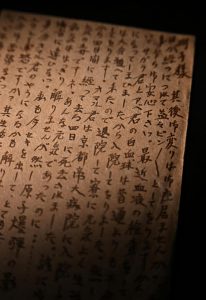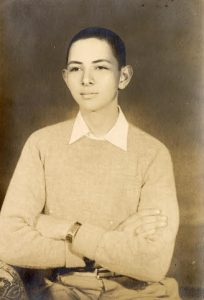Documenting Hiroshima of 1945: In early September, death notice for Southern Special Student delivered
Sep. 7, 2024
by Minami Yamashita, Staff Writer
At the beginning of September 1945, Meiko Kurihara, 19 at the time, a resident of Hiroshima’s Aki Ward who is now 98, received a postcard while in the Hiroshima Prefecture village of Kuji (in Hiroshima City’s present-day Asakita Ward), where she had been evacuated. The postcard announced the death of Syed Omar, 19 at the time, an overseas exchange “Southern Special Student” together with whom she had endured sleeping outside on the campus of the Hiroshima University of Literature and Science (present-day Hiroshima University, in the city’s Naka Ward) after the atomic bombing. The postcard indicated Mr. Omar’s death was “undoubtedly due to the effects from the atomic bomb.”
Southern Special Students had been brought from the Southeast Asian region by the Japanese government, which had embarked on establishment of what was called the “Greater East Asia Co-Prosperity Sphere.” Mr. Omar was from present-day Malaysia and studied at the Hiroshima University of Literature and Science. He experienced the atomic bombing while at the Konan dormitory for overseas students, located around 900 meters from the hypocenter, and was forced to sleep outside on the campus with fellow students.
Ms. Kurihara had also fled to the university’s campus after she experienced the atomic bombing at Toyo Kogyo (present-day Mazda Motor Corporation), where she had been mobilized to work, after finding her home in the area of Otemachi (in Hiroshima’s present-day Naka Ward) burned to the ground. The overseas students encouraged her by telling her to keep her chin up and helped in her search for her missing father. They also shared any food they had. However, Mr. Omar developed a fever while helping care for the wounded. Ms. Kurihara said, “My mother wet a handkerchief and cooled Mr. Omar’s head as he lay on the ground.”
On August 14, Ms. Kurihara separated from the students and headed to the evacuation site. Mr. Omar left Hiroshima after the end of the war, but died in Kyoto as he was making his way back home to Malaysia. The hospital death certificate for Mr. Omar was dated September 3, but the postcard sent to Ms. Kurihara by Abdul Razak, an overseas student from the same locale as Mr. Omar who died in 2013 at the age of 88, indicated the date of death to have been September 4. The postcard also revealed Mr. Razak’s concerns. “I now have a cough and am having a hard time. I might follow the same fate as that of Mr. Omar.”
At the time of the bombing, nine such Southern Special Students were enrolled at the Hiroshima University of Literature and Science. Eight experienced the atomic bombing, which took the lives of Mr. Omar and Nik Yusof, 19 at the time, who was also from Malaysia. In early September, Ms. Kurihara also started suffering acute effects from A-bomb radiation, including a fever and hair loss.
(Originally published on September 7, 2024)
At the beginning of September 1945, Meiko Kurihara, 19 at the time, a resident of Hiroshima’s Aki Ward who is now 98, received a postcard while in the Hiroshima Prefecture village of Kuji (in Hiroshima City’s present-day Asakita Ward), where she had been evacuated. The postcard announced the death of Syed Omar, 19 at the time, an overseas exchange “Southern Special Student” together with whom she had endured sleeping outside on the campus of the Hiroshima University of Literature and Science (present-day Hiroshima University, in the city’s Naka Ward) after the atomic bombing. The postcard indicated Mr. Omar’s death was “undoubtedly due to the effects from the atomic bomb.”
Southern Special Students had been brought from the Southeast Asian region by the Japanese government, which had embarked on establishment of what was called the “Greater East Asia Co-Prosperity Sphere.” Mr. Omar was from present-day Malaysia and studied at the Hiroshima University of Literature and Science. He experienced the atomic bombing while at the Konan dormitory for overseas students, located around 900 meters from the hypocenter, and was forced to sleep outside on the campus with fellow students.
Ms. Kurihara had also fled to the university’s campus after she experienced the atomic bombing at Toyo Kogyo (present-day Mazda Motor Corporation), where she had been mobilized to work, after finding her home in the area of Otemachi (in Hiroshima’s present-day Naka Ward) burned to the ground. The overseas students encouraged her by telling her to keep her chin up and helped in her search for her missing father. They also shared any food they had. However, Mr. Omar developed a fever while helping care for the wounded. Ms. Kurihara said, “My mother wet a handkerchief and cooled Mr. Omar’s head as he lay on the ground.”
On August 14, Ms. Kurihara separated from the students and headed to the evacuation site. Mr. Omar left Hiroshima after the end of the war, but died in Kyoto as he was making his way back home to Malaysia. The hospital death certificate for Mr. Omar was dated September 3, but the postcard sent to Ms. Kurihara by Abdul Razak, an overseas student from the same locale as Mr. Omar who died in 2013 at the age of 88, indicated the date of death to have been September 4. The postcard also revealed Mr. Razak’s concerns. “I now have a cough and am having a hard time. I might follow the same fate as that of Mr. Omar.”
At the time of the bombing, nine such Southern Special Students were enrolled at the Hiroshima University of Literature and Science. Eight experienced the atomic bombing, which took the lives of Mr. Omar and Nik Yusof, 19 at the time, who was also from Malaysia. In early September, Ms. Kurihara also started suffering acute effects from A-bomb radiation, including a fever and hair loss.
(Originally published on September 7, 2024)









